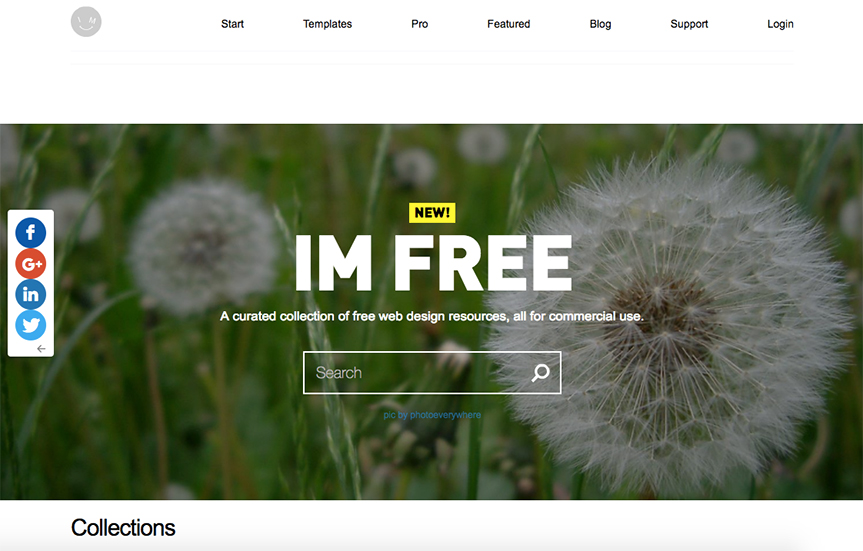Tuesday 26 February 2019
Thursday 21 February 2019
Wednesday 20 February 2019
Tuesday 19 February 2019
The Ultimate Guide to Parallax Scrolling: Best Practices, Examples and Tutorials
The idea of parallax design is simply an awareness of movement. More specifically, the word 'parallax' is used to describe the perception of distance between objects while moving along a line of sight. For example the objects nearest to you in space will seem to move quicker and more dynamically than "background" objects. So parallax is just a measurement of the difference in position between 2 points from the viewer's perspective. Since the objects aren't really moving it's just a type of illusion like 2D animation.
One of the simplest ways to understand design is through example. Let's take a glimpse into specific trends used to create parallax design features in website layouts.
The post The Ultimate Guide to Parallax Scrolling: Best Practices, Examples and Tutorials appeared first on Vandelay Design.
from Vandelay Design https://www.vandelaydesign.com/parallax-scrolling-best-practices-examples-and-tutorials/
Monday 18 February 2019
Is Your Web Design SEO Workflow Optimized?

Search engine optimization projects can be very complex, from SEO audits to content development. Having an optimized strategy on how to approach SEO for web designers not only ensures your design team has clear project direction but also increases client satisfaction. Is your SEO workflow optimized? Here are a few productivity tips to make sure your strategy is fully-optimized.
Make SEO Project Management Visual
This is a very important tip to improve productivity and optimize your SEO workflow. Unfortunately, this is where many SEO and marketing agencies fall short on projects. By having a visual representation of a project, you and your team can see the progression of projects and tasks, as well as what is still to do.
This also helps keep tasks from falling through the cracks, especially since search engine optimization projects are so complex. There are plenty of ways you can approach this. One way is manually, but that can be time consuming. The other is using process documentation software that does the work for you.
Process documentation is a roadmap for your organization—it helps you identify the current state of a process to know how you can improve it. Any task that is done more than once or completed by multiple people needs to be documented.
Develop a Task Workflow for Maximum Productivity
Simply outlining tasks, or sprints within the project backlog is great, but doesn’t necessarily enhance the overall productiveness of your SEO agency. To truly ensure workflow is optimized, you need to develop a workflow for tasks within the project workflow. It is kind of like setting small goals supported by a detailed plan to achieve on big goal down the road.
There are four elements of a task workflow that is highly productive for SEO, or any other project management process. These include, task planning, daily check-ins, review and feedback sessions, and post task analysis to improve strategies.
1.Task Planning
This is the strategizing stage of a task and answers the what and how questions. For example, let’s say one SEO task, or sprint within a client project is to create six location based landing pages to capitalize on local search results. Task planning would consist of the what is needed to accomplish these pages, like location specific keywords, addresses, phone numbers, and content, as well as how to implement these pages.
It is important to keep task planning time efficient, since some tasks don’t need a lot of strategy to get started. In other words, don’t spend an hour strategizing the what and how when it comes to creating a single web page. Utilize your time efficiently.
2. Daily Check-Ins
This is a very important part of increasing project productivity. Essentially, daily check- ins are quick 15 to 20 minute meetings where project anagers, SEO managers, and team members gather to update one another on tasks and the overall pace of the project.
For instance, if you were a project manager, you would huddle your team and find out what each team member has completed from their task list, what they are currently working on, and any issues that need to be resolved. Then you can jot down notes, move the needle on the visual project board, and address issues.
Daily check-ins also give you a clear picture of the entire project in a very short amount of time. This helps keep team communication open, and also allows you to update the client on progress and hiccups moving forward.
3. Review and Feedback Sessions
These sessions are imperative to ensure projects remain mission focused, based on the client business objectives defined by the project manager and SEO manager. By looking at all completed tasks, project managers can evaluate work done and examine it based on meeting client expectations.
If something seems out of place, the project manager can connect with the team and make tweaks on those completed tasks to ensure they are perfect before being closed out. These review and feedback sessions are great for client updates too. You can show clients how the project is progressing and highlight the benefits of each task for the main business aim.
4. Post Task Analysis
Each SEO project is unique, even if you deal with a specific industry niche. This makes post task analysis vital to keeping your SEO workflow optimized on future projects. For example, you and your team may identify a task or sprint that could have been paired with another task for more efficient progress. These sessions generally happen bi- weekly or monthly.
● Main questions to address during the post task analysis include:
● What did we learn from the tasks?
● What issues did we identify?
● How did we solve the problems?
● What areas could we make better?
After the meeting, the project manager and SEO manager can huddle and develop two potential new strategies that can be implemented next time around to increase productivity.
Wrapping Up . . .
Optimizing your web design SEO workflow is essential to growing your client list, as well as retaining existing clients. Using a strategic planning model like the one outlined above can make this happen. Search engine optimization is complex and depending on the size of the project, can be downright overwhelming. Is Your Web Design SEO Workflow Optimized?
Read More at Is Your Web Design SEO Workflow Optimized?
from Web Design Ledger https://webdesignledger.com/is-your-web-design-seo-workflow-optimized/
Friday 15 February 2019
40 Beautiful Church Website Designs
For many churches the website is an invaluable communications tool. The website can be extremely useful for helping new people to find the church, which can increase the growth of the church. Also, the website can help regular attendees and church members to get information on programs and events of the church.
Despite the enormous possibilities for church websites, many of them are ineffective. With that in mind let's take a detailed look at the subject of church websites, what makes them effective, and showcase some of the best examples.
The post 40 Beautiful Church Website Designs appeared first on Vandelay Design.
from Vandelay Design https://www.vandelaydesign.com/best-church-websites/
Thursday 14 February 2019
Wednesday 13 February 2019
Monday 11 February 2019
Friday 8 February 2019
How Ransomware Attacks Target WordPress Sites
WordPress remains THE most popular platform for blogging and content management, with a a full 30% of websites on the internet using it.
As a result of this popularity, hacking attempts and other instances of cybercrime, especially ransomware attacks, are on the rise.
Starting in 2017, analysts began to see an increase of the EV Ransomware virus infecting WordPress installations and putting real user data in jeopardy. As the number of these instances increases, so does the financial ransom that the cybercriminals attempt to extort.
This article will provide an overview of how ransomware viruses can affect WordPress installations and a guide for defending your own website against such an attack.
Basics of Ransomware Attacks
[image 1]
Before a hacker can execute a ransomware attack on a company or organization, they first have to find a way to install their malicious virus. This most often occurs through social engineering or a phishing scam, where the attacker gains access to a computer or network component.
For example, the hacker may send out a bulk email message urging recipients to click on a link and enter their corporate credentials into the web form that opens. Even if only a single user in a large organization performs this action, it can spread damage throughout the network.
At this point, the hacker installs the malware onto the compromised computer and then tells it to transfer to other network nodes. Once a certain threshold is reached, users will be locked out of their workstations and may see a message on screen demanding a ransom.
This type of cybercrime dates back to the early days of the world wide web, with the first known ransomware virus being deployed in 1989 against the healthcare industry. Such attacks have grown more intricate over the years, but fortunately so have the methods of defense.
WordPress Attacks
[image 2]
System administrators may assume that WordPress installations are not vulnerable to outside attacks given that they mainly host text and image content. However, ransomware viruses are now targeting WordPress because of the platform’s connection to the open internet.
Recent attacks have originated as the result of compromised passwords within the WordPress console. If users are not required to maintain strong WordPress passwords and change them on a regular basis, then all content stored on the platform is vulnerable to attack.
After gaining access to the WordPress admin console, a hacker can upload malicious files directly to the organization’s main web directory. In the past, ransomware viruses were usually deployed through a rogue EXE file, but nowadays WordPress installations are being brought down by PHP files.
When one of these malicious PHP packages is uploaded to a WordPress directory, the software begins encrypting all other data located in adjoining folders. Original files are deleted and replaced with objects that have a different extension.
When normal users attempt to access the WordPress console, they find themselves locked out and redirected to a page demanding a ransom payment, typically in the form of Bitcoin or another cryptocurrency.
Most experts agree that such a ransom should not be paid by the affected organization, as there is no guarantee the attacker will ever unlock the data they’ve encrypted.
Ransomware Protection
[image 3]
The first step towards defending your WordPress installation against ransomware attacks should be educating users about the threats and risks involved. It’s important to emphasize that such hacks propagate through a single infiltration point, often via email spam or rogue hyperlinks.
Virtual Private Network (VPN)
One good preventative solution is to use a VPN. Growing in popularity as websites continue to suffer an ever-evolving onslaught of vulnerability probes, a VPN works in conjunction with your ISP. When deployed properly, it encrypts both ends of an internet connection, leaving hackers gazing at gobbledygook and (hopefully) moving on to easier prey.
When evaluating VPNs it’s important to know that not all are made equal. Lucas Johnson of Privacy Australia has some great vpn reviews based on logging, speed, country or establishment and also P2P file transfer policy.
Download from Official Sources
When you first set up a new WordPress installation, whether it is hosted locally or through a cloud provider, you should take precautions when it comes to cybersecurity.
WordPress themes are the configuration files that give your website its color pallet and general design structure. Some website owners will develop their own theme, but most obtain one from a third-party.
Beware of any WordPress themes that are offered as free downloads, as these may contain malicious files that could spawn a ransomware virus once installed. Instead, focus your theme search in the official WordPress community directory, which offers a range of options that have been verified as safe to install. The same precautions should be taken when adding plugins and other WordPress customizations.
Embrace Regular Updates and Backups
If you are running your WordPress instance on a local server environment, keep back-end systems up-to-date. Operating systems are patched regularly to protect against new cyber threats and the same goes for the WordPress software itself. You can check your WordPress version through the admin console and set up automatic update installation.
Data files are typically the main target of ransomware attacks. If your WordPress system falls victim to such a hack, you may lose all of the information in your website’s directory.
Keeping daily or hourly backups is the best practice to take if you want to minimize data loss and downtime. Experts agree that you should store WordPress backups in both local and outside locations, which is made easier with cloud storage solutions.
Conclusion
Organizations of all sizes are at risk of being infiltrated by a ransomware attack. But those who are prepared and diligent will be able to block the hack and bounce back quickly.
To keep your WordPress website fully secure, consider investing in a full-scale security solution that will protect your data and monitor your network for network-based threats. These may add a cost to your bottom line, but ensuring the security of your data will save you a lot of frustration in the long run.
The post How Ransomware Attacks Target WordPress Sites appeared first on SpyreStudios.
from SpyreStudios https://spyrestudios.com/how-ransomware-attacks-target-wordpress-sites/
Wednesday 6 February 2019
30+ Inspirational ECommerce Website Designs
For e-commerce websites the design and layout of the site can have a huge impact on sales because of usability, in addition to just the importance of making a good first impression with new visitors. A well-designed e-commerce site will provide the user with a much more pleasant experience and will make it easier for them to browse, search, and complete the checkout process.
In this post we'll showcase 32 e-commerce sites that look great. You'll notice that product photography is equally important to the look of an e-commerce website as the layout and graphic design. Sites that showcase the products effectively will be far more successful as a result. Hopefully this selection will provide you with some inspiration that can be put to good use in your own work.
The post 30+ Inspirational ECommerce Website Designs appeared first on Vandelay Design.
from Vandelay Design https://www.vandelaydesign.com/best-ecommerce-website-designs/
Tuesday 5 February 2019
20 Great Websites to Find Free Stock Photos

We are all tired of fake stock pictures where people shake hands in perfect suits. The era of perfectly scented stock photos is gone. Now people want to see real-life pictures on their websites, banners, and flyers.
The number of sites you can download high-quality free stock photos increase day by day. Just in case, you can’t find a photo you need on one site, you can use another one.
In this showcase, we put together 20 great websites to find beautiful stock photos. Most of images featured there fall under Creative Common Licence, so you can use them without author credit. Just scroll down and choose the site to pick a stunning photo.
unsplash
Pexels
freephotos
Foodies Feed
IM Free
Foter
Pixabay
StockSnap
Death to The Stock Photo
Picjumbo
The Pattern Library
Gratisography
Big Stock</h3>

Life of Pix
Free Refe Real Stock Photos
Magdeleine
Jay Mantri
My Stock Photos
Public Domain Archive
Picography
Read More at 20 Great Websites to Find Free Stock Photos
from Web Design Ledger https://webdesignledger.com/20-great-websites-to-find-free-stock-photos/




















